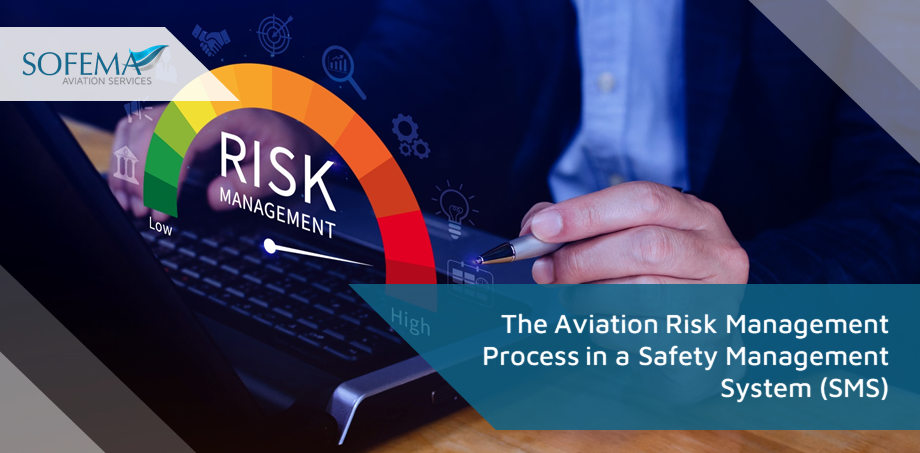Sofema Aviation Services (SAS) considers the key aspects of the Risk Management Process.
Introduction
The Risk Management Process in an SMS integrates hazard identification, risk assessment, and mitigation to protect aviation operations. By prioritizing risks and systematically addressing them, organizations can allocate resources efficiently, reduce exposures, and ensure ongoing safety performance. Continuous monitoring and fostering a strong safety culture are critical to sustaining the effectiveness of the SMS.
- The Risk Management Process is a structured approach to identifying, assessing, and mitigating risks to ensure safety in aviation operations.
- It is a core activity that integrates hazard identification, risk assessment, and implementation of control measures to manage safety risks effectively.
Hazard Identification
Hazard identification is the starting point of risk management and involves systematically recognizing conditions or objects that can cause harm or unsafe outcomes.
Key Points
Definition: A hazard is a condition or object with the potential to cause injury, damage, or disruption.
Sources of Hazards:
- Reactive: Learning from past safety incidents or accidents.
- Proactive: Identifying hazards through audits, evaluations, and employee reporting.
- Predictive: Forecasting hazards using data and trend analysis to anticipate risks.
Examples:
- Physical Hazards: Wet surfaces, machinery issues.
- Procedural Hazards: Poorly written SOPs.
- Human Factor Hazards: Fatigue, miscommunication.
- Environmental Hazards: Wildlife, weather extremes.
Best Practices
- Conduct brainstorming sessions, audits, and surveys to collect diverse perspectives.
- Use incident reports, flight data, and trend analysis to pinpoint hazards.
- Ensure regular reviews of the hazard identification process.
Risk Assessment
Once hazards are identified, the next step is to assess the risks associated with them. Risk assessment considers two key factors:
Likelihood (Probability): How likely the event is to occur.
Severity: The potential consequences or impact of the hazard.
The Process
Evaluate Probability:
- Frequent: Likely to occur often.
- Remote: Unlikely, but possible.
- Improbable: Rare or inconceivable.
Evaluate Severity:
- Catastrophic: Fatalities or total system loss.
- Hazardous: Major injuries or significant damage.
- Minor: Negligible safety impact.
Use a Risk Matrix:
A 5×5 Risk Matrix is commonly used to determine the risk level based on probability and severity.
Example: A frequent hazard with hazardous consequences is classified as high risk and requires immediate action.
Risk Tolerability:
Risks are categorized as:
- Intolerable: Requires immediate action to mitigate or stop the activity.
- Tolerable with Mitigation: Implement controls to reduce risks to an acceptable level.
- Acceptable: Minimal risk, monitor periodically.
Risk Mitigation
Risk mitigation involves implementing measures to reduce the likelihood or severity of risks.
Control Measures
- Elimination: Remove the hazard entirely.
- Reduction: Minimize risk through engineered controls, procedures, or training.
Preventive Actions
- Enhanced training and competence.
- Improved SOPs and safety barriers.
- Adoption of technology (e.g., automated detection systems).
Reactive Actions
- Implement recovery measures like emergency response planning.
Examples of Mitigation
To reduce foreign object debris (FOD) risks:
- Conduct regular runway inspections.
- Install FOD detection systems.
- Train ground staff on FOD management practices.
Continuous Monitoring and Review
Risk management is an ongoing process. Mitigations must be regularly monitored to ensure their effectiveness and relevance.
Key Activities
- Use Key Performance Indicators (KPIs) to track safety performance.
- Conduct safety audits and reviews to assess risk controls.
- Encourage feedback from employees and stakeholders.
Update risk assessments when:
- Operational changes occur (new equipment, processes).
- Safety incidents highlight new hazards.
Documentation and Communication
Effective documentation of the risk management process is vital:
- Maintain records of hazard identification, risk assessments, and mitigations.
- Use a centralized system to ensure easy access to safety data.
- Communicate risks and controls across all organizational levels.
Challenges in Risk Management
- Inconsistent Hazard Identification: Failure to identify latent hazards.
- Blame Culture: Discourages reporting of near misses and hazards.
- Resource Constraints: Limited budgets for training and tools.
- Lack of Standardization: Inconsistent risk assessment methods.
- Failure to Monitor Residual Risks: Overlooking post-mitigation risk evaluations.
Best Practices for an Effective Risk Management Process
- Embed risk management into the organizational culture and daily operations.
- Provide regular training to improve awareness and competence.
- Use data-driven insights to proactively identify hazards and trends.
- Engage stakeholders across departments for a holistic risk assessment.
- Apply consistent tools like the 5×5 risk matrix and bow-tie analysis.
Next Steps
Sofema Aviation Services and Sofema Online provide classroom, webinar, and online training.
Explore our course: SMS Hazard Identification & Risk Assessment – 1 Day
Follow this link to our Library to find & download related documents for Free.
For comments and questions, please email team@sassofia.com
Tags:
Risk Assessment, Safety Management System SMS, Hazard Identification, SAS blogs, FOD, Risk Matrix, Key Performance Indicators (KPIs), stakeholders, Preventive Actions, continuous monitoring, Risk Management Process, Documentation and Communication, Best Practices for an Effective Risk Management Process, SOPs




